
This site uses cookies, by continuing to use this site you accept the terms of our privacy policy
Feed 2.0 Loading...
Gills Harbour At Biggest Electricity Conference
23rd September 2014
Scotland's most Northerly port represented at 2014 biggest conference of the year devoted solely to electricity from the seas.
The managers of the Scottish mainland's most Northerly port, on the shores of the Pentland Firth's Inner Sound, were represented at this week's Marine Conference in Inverness organised by trade representative body Scottish Renewables (SR).
The two-day, top-level event, held in the city's Eden Court Theatre, is the biggest gathering of the year in Scotland for persons professionally involved in 'harvesting' tidal streams to generate electricity or in capturing the energy of the waves; SR runs separate events for longer-established offshore wind, hydro-electricity, biomass, solar energy and other 'green' sources of electricity.
Gills Harbour Ltd, (GHL) that owns and operates the busy small port, was attending in its role as a corporate member of Scottish Renewables, a grouping with its administrative HQ in Glasgow that held its fifth annual gathering in the prestige riverside venue on September 23rd and 24th, 2014.
The busy little port, best known as the (Scottish) Mainland terminus for the short-sea route year-round RO.RO ferry services operated thrice-daily to Orkney by its partial lessee Pentland Ferries Ltd, is increasingly coming into its own as a base for activities around the extraction of electricity from the powerful tidal-streams that flow less than a mile off Gills Harbour's main entrance channel.
Community company Gills Harbour Ltd is being represented at the Inverness congress by its chairman ex-Councillor Bill Mowat , of John O'Groats, who himself is a Fellow of the Energy Institute.
The harbour belongs to 600 persons living on the Pentland Firth coast of Canisbay, and it has directors and members from a wide-cross-section of folk in its 'home' area from West Mey to John O'Groats, inclusive.
On the eve of the conference SR revealed the result of its recent survey that showed that £217 million has been invested in Scottish wave and tidal developments, a field that supports almost 600 full-time equivalent jobs in Scotland, during the previous five years.
Mr Mowat said; 'I am certain that there are going to be a lot of enquiries about Gills Harbour and much attention on the port at the SR gathering this year.
'Practically everyone involved in the nascent tidal-electricity sector knows where Gills Harbour and the Inner Sound are situated; that's quite a change for the better from the position just five years ago when SR came to Inverness for its first specialist Marine Energy congress.
'Many of those present will have visited the facility, not just to inspect it, but also to catch the boat to Orkney on their way to the European Marine Energy Centre there. Its separate wave and tidal test-sites support over 250 jobs on the islands'.
'But particularly this year, there will be intense interest in two things about to happen here. The first is the industry's move from using simply prototype devices to a 'demonstration array' of 4-6 'production' turbines that are being installed on the seabed of the Inner Sound in 2015 and 2016.
'All lie within 1.5 miles from Gills and most of the principals of vessel-owing marine engineering companies are well aware of the convenience of our location in relation to the pioneering MeyGen Ltd development, in which there is keen international interest.
'There is also the September 2014 'generic' study from Gills Harbour into the natural sea-turbulence within the 35 metre deep water-column of the Inner Sound being undertaken by Government-sponsored The Carbon Trust just now . I've had a lot of queries about it from the trade press and I'm aware of the world-wide industry interest in the subject.
'This matter is important because mid-column sea-water turbulence can affect both electricity output and the longevity of components used in the manufacture of the recently-devised 'horizontal hydro' sea-water submerged turbines. I've just had a note from a marine civil engineer in Newcastle who is attending mainly to get further information about it'.
Mr Mowat is expecting some detailed queries about the tidal streams, some of which he may refer to GHL director William Simpson, of Gills, who runs his family's sheep-farm on Stroma island and had made hundred of crossings of the Inner Sound or to Billy Magee, Gills Harbour's retired treasurer who has had a lifetime's experience in operating small, low-powered, traditional yoles from Gills.
He said that, for matters such as inshore counter-currents known as 'burths' and moving 'tide-edges', the two above-mentioned have detailed knowledge about how those operate in widely-differing swell and weather conditions in the Inner Sound or 'Soon' as its known locally.
He said he would be pleased to tell fellow-delegates about important recent additions to the port's capabilities that are in progress from Pentland Ferries Ltd's Gills-based direct labour squad. This will provide a guaranteed 4 metres water-depth at lowest tides throughout its main entrance channel and the almost-complete 100 metres X 100 metres ship-turning 'circle' to allow all vessels to access or egress the harbour in forward motion.
A 70 metre extension to Gills Harbour's main breakwater/berth is expected to be in place during the first half of next year. It will be 'off-set from the present 160 metre long facility. This recycled former floating dry-dock will provide around minus six metres of water at Lowest Astronomical Tides (LAT), which occur during some equinoctial 'spring' tide cycles in September and March, while tghe 'offset' will allow normal ferry operations to continue while marine renewables vessels are berthed there.
The original 150-yard-long Gills Pier was built just over a century ago specifically to diversify the base of the Canisbay economy by encouraging local employment opportunities away from near-total reliance on crofting; small-scale agriculture.
It was partially-funded under the Government's first-ever 'regional development agency'.
But Mr Mowat said that he was expecting brickbats as well as praise; one marine-engineering contractor was in touch just last week wondering why more progress had not been made by GHL in providing safe, all-tides year-round berths in its Inner Basin for the 25-metre long class of 'multi-cat' many-purpose vessels that his company operates.
This past spring (2014) GHL spent £30,000 in cleaning out loose rocks and removing silt from the Caithness flagstone sea-bed floor of the basin, but was unable to afford to deepen it further at this time to provide a guaranteed 2.5 metre of water at the very lowest tides.
Several of MeyGen Ltd's top managers are scheduled to speak at the Inverness conference about the 'world-first' nature of its £51 million Inner Sound development.
Related Businesses
Related Articles
21/10/2022
Three Cats At Gills Harbour
Two catamaran work-boats berthed at Gills Harbour this week with the trans-Pentlnd ferry MV Alfred, also a catamaran, in the background. The larger workboat is MPC Athenia which was being used as a floating base or ROVs - remote underwater vessels, for detailed inspections on the three turbines operating at the MeyGen demonstration subsea site one and a half miles off Gills Harbour.
12/6/2022
GILLS HARBOUR Ltd ANNUAL GENERAL MEETING
GILLS HARBOUR Ltd - ANNUAL GENERAL MEETING at JOHN O'GROATS VILLAGE HALL, MONDAY JUNE 13th @ 7.30 PM. GILLS HARBOUR IS THE ONLY OFFICIALLY-RECOGNISED 'ECONOMIC DEVELOPMENT AREA' IN NE CAITHNESS.22/3/2021
Latest Boats At Gills Harbour For Work At Meygen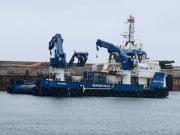
£10 million 'Isle of Jura' temporarily based at Gills Harbour in Far North of Scotland for her crew's debut tasks in the tidal-stream electricity field at the MeyGen sub-sea site, one mile off the little Caithness's port entrance channel. One of the UK's most modern marine renewables service vessels made her debut calls at community-owned Gills Harbour, near John O'Groats, over the 2021 Spring Equinoctial weekend.
23/2/2021
Busy Gills Harbour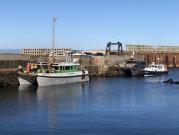
Its been a busy few days at local community-owned Gills Harbour ..... sometimes in suberb sunny weather as here ...
26/11/2020
Energy Developments Continue at Gills Harbour and the Pentland Firth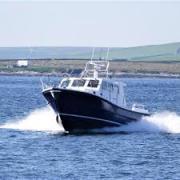
The company behind the world-leading tidal-stream prototype power plant in the Pentland Firth's Inner Sound is set to start manufacturing a new-style turbine that is hopes will reduce the project's generating costs. Simec Atlantis Energy (SAE) and a privately-owned specialist engineering firm from Spain's Bay of Biscay coastline have jointly been conducting 'research and development' (R& D) on the project for almost a year and are now ready to give it the go-ahead.
8/10/2020
New Generation of office-bearers set to step up at Gills Harbour Ltd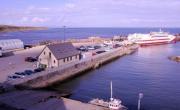
A new generation of younger local folk look set to take over the reins of running Gills Harbour Ltd, the local company that owns and operates the busy little port on the shores of the Pentland Firth's Inner Sound that holds its AGM this Saturday (10.10.20) morning at 10:00 am. The influx of younger blood comes after two key directors of the group that had run 'Canisbay's Peoples Port' both announced their retirement from office, whilst another Gills Harbour Ltd (GHL) office-bearer has declined to seek re-election.
19/8/2020
MV Alfred And MV Pentalina Together At Gills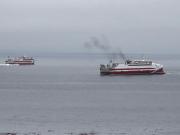
An 'old friend' returns to Gills Bay after an absence of manymonths. The 2,400 tonne 70 m.
16/8/2020
Normand Cutter, The Norwegian-owned Offshore Construction Vessel at Gills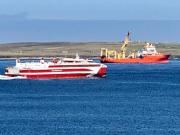
Here is the Normand Cutter, the Norwegian-owned offshore construction vessel that has been the base for works on Simec Atlantis Energy's (SAE's) MeyGen site in the Pentland Firth's Inner Sound, off Gills Bay during the current neap-tide sequence, that has lasted most of the week commencing 11.08.20. Picture by retired C of S Kirk Minister the Rev Lyall Rennie, who lives at Lower Warse, Canisbay, on the shores of Gills Bay..
9/10/2019
New Ferry For Pentland Ferries Arrives Safely
Scotland's most modern + environmentally-friendly, fuel-efficient ROPAX ferry ship rge MV Alfred, arrived AM today (Wed 09.10.19 at St Margarets Hope. The boat went round to Kirkwall immediately at the end of 9,000+ miles voyage from the Strategic Marine yard near Ho Chi Minh city (ex.
20/3/2019



